 |
|
Children in this study treated with repeated low-level red-light therapy twice daily at 100% power showed a significant reduction in myopia progression at six months. Photo: iStock. |
Editor’s Note: As part of our “Year in Review” retrospective, we’ve selected the top 30 news stories of the year and are re-sharing them as we close out 2022. Follow along as we count down to number 1!
This story was originally published on August 31, 2022.
No. 30 biggest news story of 2022:
An emerging treatment for slowing myopia progression is repeated low-level red-light therapy (RLRL). Through several clinical trials, the intervention has shown to be a safe and effective method of myopia control that can even be used remotely. Because many of these studies have lacked adequate control groups, researchers recently aimed to assess the efficacy and safety of RLRL through the first sham device-controlled, randomized, double-blind clinical trial. They found that the treatment was safe and that the children treated with RLRL at 100% power had significantly reduced myopia progression and axial elongation over six months compared with those who received treatment via a sham device at 10% power.
The trial included 112 Chinese children aged seven to 12 with myopia of at least -0.50D, astigmatism of -1.50D or less and anisometropia of 1.50D or less. Half of the cohort was randomly assigned to receive RLRL treatment at home via a desktop red light therapy device, while the other half was treated using the same device but only at 10% power. All participants were instructed to follow a treatment schedule of three minutes per session, twice per day, with at least four hours between each session. The researchers measured cycloplegic refraction and axial length at baseline and six months.
They reported that the mean spherical equivalent refraction change over six months was 0.06D in the RLRL group and -0.11D in the sham device control group. The average axial length growth was less in the RLRL group, too, at 0.02mm compared with 0.13mm in controls. The researchers also analyzed the data through multivariate generalized estimating equation models, which confirmed their finding that children in the RLRL group had less myopia progression and axial elongation than those treated with the sham device.
“In the current study, we demonstrated that RLRL treatment was able to achieve spherical equivalent refraction regression >0.25D and axial length shortening >0.05mm at the six-month follow-up in 16.1% and 23.2% of myopic children, respectively,” the researchers wrote in their paper in Ophthalmology.
Notably, the treatment was well tolerated by study participants and caused no treatment-related adverse effects. Altogether, the researchers noted that these findings contribute to the evidence that RLRL therapy is an effective and safe intervention against myopia progression. In the future, they suggest studies focus on evaluating the potential dose-response relationship and optimal intensity of treatment.
Dong J, Zhu Z, Xu H, He M. Myopia control effect of repeated low-level red-light therapy in Chinese children: a randomized, double-blind, controlled clinical trial. Ophthalmology. August 24, 2022. [Epub ahead of print]. |

